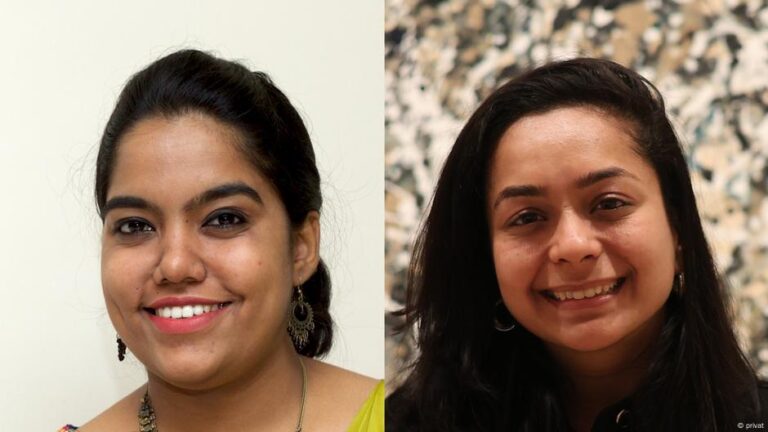‘Art is my accessibility’: Janhavi Khemka
Janhavi Khemka’s mother has always been the source of her inspiration as an artist. Her earliest memories of making art involve her mother: “My mother would help me with my school assignments, explaining them through hand gestures, facial expressions, and body language.”
Khemka (above right), who was born in Varanasi, India in 1993, is hearing-impaired. Her mother taught her to read lips in Hindi at a young age and encouraged her artistic exploration. But she died when Khemka was 15.
“The impact she left on me helped me navigate an able-bodied world, further inspiring my art through light, touch, experimental sound, and tactile mediums,” Khemka said in a written interview with DW.
It is in this able-bodied world that Khemka is making a name for herself as an interdisciplinary artist working across a diverse array of mediums, from woodcut to painting to performance and animation. She earned an MFA (Master of Fine Arts) from the prestigious School of the Art Institute of Chicago and, prior to that, one from Visva-Bharati University at Santiniketan, a historic education center based in West Bengal that is deeply rooted in Indian culture and traditions.
“Santiniketan opened a new world for me, as it was my first time being away from home. It helped me grow, understand how my disability shapes my identity. It was transformative, helping me expand my perspectives, connect with people and artists, and deepen my engagement with art.”
Friends and mentors have supported Khemka’s career as an artist, but she still faces a lack of accessibility and is “constantly self-aware” and having to explain her experience to others, which can be “exhausting.”
Khemka’s art has been featured in numerous solo and group exhibitions. Much of it relates to her being a hearing-impaired person who experiences sound through vibration. Some of her works, like “Impress/ion” and “Your name, please?” are interactive, involving a direct exchange with individual audience members.
In 2021, she created “Letter to My Mother” — a vibrating platform adorned in a projected animated light pattern consisting of lips made from woodcut prints. It recalls how her mother taught her to lip read on a mat. For her, “It’s a personal experience that connects me with my mom in a way that words alone cannot express.” For viewers, it allows them to experience sound in a tactile fashion and ushers them into an intimate moment in the artist’s life.
“My greatest success is feeling comfortable in the world, where I can exist freely and confidently,” Khemka says.
‘A woman is not born, she is created’: Mayuri Chari
A free and confident existence: This is always what conceptual artist Mayuri Chari hopes for herself as a woman — and for women everywhere.
She prefers the term priorities to success. And her priorities are speaking through her work, which focuses on the female body, and expressing what she wants to tell people, not what people want her to tell.
In fact, they don’t always like what her art tells.
Whether through print, textile, film or even cow dung, Chari examines and challenges how women are seen, positioned and treated across various strata of Indian society.
“They are not stories or tales,” she says of her artwork’s messages about women. “They are reality.”
She started experimenting with the female body as a subject during her MFA at the University of Hyderabad. For one semester show, she made large prints of her own body. She saw the work artistically, for its texture and colors. “But they,” she said of her classmates and other viewers, “their gaze was totally different. They saw it as a vulgar thing and suggested that I shouldn’t do this openly.”
Their response only got her thinking more. “I started to question why: Why are people seeing the body as something vulgar, sexy? Why not as a creative thing?” she told DW in a phone interview from her home in rural Maharashtra.
In Chari’s work, the female body is neither a goddess nor an object of consumption but rather a statement of self-awareness. Yet her art has been controversial in India for simply featuring nude female bodies — realistic, imperfect, bold. Indian galleries have rejected her works and exhibition venue owners have asked her to remove pieces.
Despite such institutional rejection, her work resonates strongly with Indian women, who see themselves and their experiences reflected in her art. Chari says that women often come up to her at shows and whisper in her ear, “I feel the same thing. This happens to me, also.”
Her work has been garnering international attention in recent years. Her installation “I WAS NOT CREATED FOR PLEASURE,” was featured at the 12th Berlin Biennale, in 2022, and she was an artist in residence at the 2024 India Art Fair.
Like Janhavi Khemka, Chari’s family also influenced her path as an artist — though not always positively. Born in the coastal state of Goa in 1991, Chari spent a lot of time as a child watching and helping her father, a carpenter, create furniture and carvings. She started making art in school, where her teachers encouraged her.
But after her father died, Chari was forbidden by her family, in particular her elder uncle, from pursuing higher-level studies. She defied them and did it anyway, earning a master’s in fine arts with the help of friends and scholarships. Her now husband and fellow artist, Prabhakar Kamble, provided her with important support and resources in her early days out of school.
While Chari’s work centers on society’s positioning of women, she feels it is caste, more than gender, that has affected her reception.
“Everything depends on the caste, where you come from. I came from a low caste, and big galleries always appreciate the high caste people. They notice them, and they always want people who speak well in English, and who have money,” she explains.
Advice for aspiring young artists
Chari’s current projects include a short documentary about the lives of rural female sugar laborers and textile projects dealing with trousseau-making — a bridal needlework practice that Portuguese colonizers brought to her home state of Goa and that continues to be passed on today from mother to daughter; she learned it from her own mother.
Janhavi Khemka’s mother will also continue to be at the forefront of her work. In the future, she hopes to make a movie using woodcut print animation exploring their relationship. Drawing on her own experience, she tells younger artists to “face failure with courage, hold on to patience and hope, and be ready to meet challenges head-on.”
Chari, for her part, advises younger artists to make sure they remain free and independent thinkers. “They shouldn’t follow others,” she says. “Or follow the thoughts, ideas, what other artists are doing, but don’t copy them.”
Edited by: Brenda Haas


